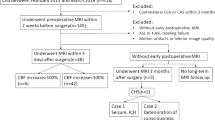Abstract
Background: Cerebral perfusion during carotid cross-clamping depends on collateral function of the circle of Willis. The aim of this study was to determine the value of 3D Phase-Contrast (3D PC) MR angiography in predicting pre-operatively the need of shunting. Methods: 3D PC MR angiography were performed in 121 patients before carotid endarterectomy under locoregional anaesthesia. Based on the MR analysis, the risk of cerebral ischemia–hypoxia during clamping was classified as high, moderate and low. The analysis was then correlated with intraoperative neurological examination. Results: In patients with high risk of cerebral ischemia (n=9), immediate cerebral ischemia developed in all patients within one min of clamping (P<0.001). All nine underwent shunt placement. In six of the patients with moderate risk (n=46), cerebral ischemia occurred between 20 and 25 min after clamping; All occurred during intraoperative hypotension. Conclusion: 3D PC MR angiography can significantly determine the need of shunting in patients with important risk of immediate intraoperative cerebral ischemia. It also focuses on the intraoperative blood pressure stability in patients with moderate risk of ischemia.

Similar content being viewed by others
References
Alpers BJ, Berry RG, Paddison RM (1959) Anatomical studies of the circle of Willis in normal brains. Arch Neurol Psychiat 81:409–418
Doblar DD, Plyushcheva NV, Jordan W, McDowell H (1998) Predicting the effect of carotid occlusion during carotid endarterectomy. Comparing transcranial Doppler measurements and cerebral angiography. Stroke 29:2038–2042
Fields NS, Bruetman ME, Weibel J (1965) Collateral circulation of the brain. Williams Wilkins, Baltimore
Frawley JE, Hicks RG, Gray LJ, Niesche JW (1996) Carotid endarterectomy without a shunt for symptomatic lesions associated with controlateral severe stenosis or occlusion. J Vasc surg 23:421–427
Halsey JH (1992) Risks and benefits of shunting in carotid endarterectomy The International Transcranial Doppler Collaborators. Stroke 23:1583–1587
Hoksbergen AWJ, Legemate DA, Ubbink DT, Jacobs MJ (2000) Collateral variations in circle of Willis in atherosclerotic population assessed by means of transcranial color-coded duplex ultrasonography. Stroke 31:1656–1660
Kim GE, Cho YP, Lim SM (2002) The anatomy of the circle of Willis as a predictive factor for intra-operative cerebral ischemia (shunt need) during carotid endarterectomy. Neurol Res 24:237–240
Lawrence PF, Alves JC, Jiche D, Bhirangi K, Dobrin PB (1998) Incidence, timing, and causes of cerebral ischemia during endarterectomy with regional anesthesia. J Vasc Surg 27:329–337
Lazorthes G, Gouaze A, Salamon G (1976) Vascularisation et circulation de l’encéphale. Masson, Paris
Lee JH, Choi CG, Kim DK, Kim GE, Lee HK, Suh DC (2004) Relationship between circle of Willis on 3D Time-of-Flight MR angiograms and transient ischemia during vascular clamping of the internal carotid artery during carotid endarterectomy. Am J Neuroradiol 25:558–564
Leffers AM, Wagner A (2000) Neurologic complications of cerebral angiography. A retrospective study of complications rate and patient risk factors. Acta Radiol 41:204–210
Liebeskind DS (2003) Collateral circulation. Stroke 34:2279
Mc Carthy RJ, Nasr MK, McAteer P, Horrocks M (2002) Physiological advantages of cerebral blood flow during carotid endarterectomy under local anaesthesia. A randomised clinical trial. Eur J Vasc Endovasc Surg 24:215–221
Miralles M, Dolz JC, Cottillas J (1995) The role of the circle of Willis in carotid occlusion: assessment with phase contrast MR angiography and transcranial duplex. Eur J Vasc Endovasc Surg. 10:424–430
Patrick JT, Fritz JV, Adamo JM, Dandonna P (1996) Phase-contrast magnetic resonance angiography for the determination of cerebrovascular reserve. J Neuroimaging. 6:137–143
Pistolese GR, Ippoliti A, Appoloni A, Ronchey S, Faraglia V (1993) Cerebral haemodynamics during carotid cross-clamping. Eur J Vasc Surg 7(supp A):33–38
Rutgers DR, Blankensteijn JD, van der Grond J (2000) pre-operative MRA flow quantification in CEA patients: flow differences between patients who develop cerebral ischemia and patients who do not develop cerebral ischemia during cross-clamping of the carotid artery. Stroke 31:3021–28
Schomer DF, Marks MP, Steinberg GK, Johnstone IM, Boothroyd DB, Ross MR, Pelc NJ, Enzmann DR (1994) The anatomy of the posterior communicating artery as a risk factor for ischemic cerebral infarction. NEJM 330:1565–1570
Schwartz RB, Jones KM, Leclercq GT, Ahn SS, Chabot R, Whittemore A, Mannick JA, Donaldson MC, Gugino LD (1992) The value of cerebral angiography in predicting cerebral ischemia during carotid endarterectomy. Am J Roentgenol 159:1057–1061
Visser GH, Wieneke GH, van Huffelen AC, Eikelboom BC (2000) The use of pre-operative transcranial Doppler variables to predict which patients do not need a shunt during carotid endarterectomy. Eur J Vasc Endovasc Surg 19:226–232
Wain RA, Veith FJ, Berkowitz BA, Legatt AD, Schwartz M, Lipitz EC, Haut SR, Bello JA (1999) Angiographic criteria reliably predict when carotid endarterectomy can be safely performed without a shunt. J Am Coll Surg 189:93–100
Willinsky RA, Taylor SM, TerBrugge K, Farb RJ, Tomlinson G, Montanera W (2003) Neurologic complications of cerebral angiography:prospective analysis of 2899 procedures and review of the litterature. Radiology 227:522–528
Author information
Authors and Affiliations
Corresponding author
Rights and permissions
About this article
Cite this article
Bagan, P., Azorin, J., Salama, J. et al. The value of phase-contrast magnetic resonance angiography of the circle of Willis in predicting cerebral ischemia-hypoxia (shunt need) during carotid endarterectomy. Surg Radiol Anat 27, 544–547 (2005). https://doi.org/10.1007/s00276-005-0032-5
Received:
Accepted:
Published:
Issue Date:
DOI: https://doi.org/10.1007/s00276-005-0032-5




